Suikoden V
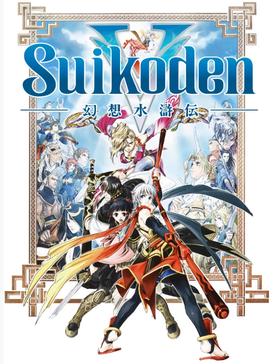
Suikoden V
A retrospective of the last true Suikoden game.
What happens when the tedium of quarantine and nostalgia collide? If you’re like me, you fall back on one of your trap games. You know the kind of game I’m referring to. A game that you’ve played at least five times, yet you can’t help yourself and inevitably replay it every couple of years. Sometimes these trap games are comforting. Other times, they are synonymous with being in a rut. Whatever the case, you know them like the back of your hand and they usually end up distracting you from other games in your library.
In this post, I will revisit a trap blast from the past: Konami’s Suikoden V. I have very fond memories of Suikoden V. It was released in 2006 about a week or two before summer school started. During that week, I recall staying up into the early hours of the morning and carving out considerable chunks of progress. For a game that invokes an artifact of magic called the Dawn Rune, there was something so inviting and peaceful about going to bed around 9 AM. More importantly, I became involved in the Suikoden community after playing this game, and I’ve maintained close friendships with a few people as a result (y’all should post in the comments). I was most active on Their Star, Due Fiumi, and Suikox. Each had only a couple thousand members, but they were so enthusiastic about Suikoden that we all felt as if the series would remain relevant for years. Unfortunately, that wasn’t the case.
For those unfamiliar with the Japanese Suikoden role-playing series, the best way to describe it would be “popular niche.” Many gamers have heard of the series and its name gets thrown around certain gaming circles. However, it never became a household RPG name like Final Fantasy or Dragon Quest. It’s probably on the same level as Capcom’s Breath of Fire that certainly has its own fanbase or casual gamers who say, “Ah, yeah. I remember that game,” but both series have sadly faded into partial obscurity as their respective companies have buried them. In Suikoden’s case, this is unfortunate because it is known for an ungodly number of recruitable characters (108 Stars of Destiny in each game), castles that become their own unique towns, and riveting storylines that deal with loss, family, betrayal, death, full-scale war, and more. Although the first game was released in Japan in 1995, the series began to receive more attention around 1999 when Suikoden II was released in North America. Although a niche PlayStation One title with a limited run, those who played the game believe that it’s not just the best Suikoden game, but one of the best Japanese RPGs of all time. Konami built on this success by releasing Suikoden III for the PlayStation 2 to critical acclaim in 2002. What also made Suikoden unique in the eyes of fans was its attention to world-building as the first three games (and Japanese “gaidens”) happened in succession: Suikoden II takes place two years after the first game and Suikoden III occurs fifteen years after Suikoden II. This chronology allowed for fans to share intricate character theories with others in the series’ small but growing community, and it also invited speculation on where future games would take place.
All seemed to be going well for Suikoden until the series’ creator, Yoshitaka Murayama, left the team before Suikoden III was even released. Although he apparently left Konami on good terms, any progression of his vision was thrown by the wayside as Suikoden IV is a prequel that takes place a whopping 150 years before the first game! The game is universally considered the weakest in the series. I mean, who had the brilliant idea of setting the game in the far past, thus alienating the succession of conflict that made the entire series interesting?!
Due to a sudden disappointing installment, Suikoden now had a problem on its hands. Furthermore, 2005/2006 was a gaming era in which more traditional RPGs were sidelined for blockbuster Western RPGs like Bethesda’s colossal Elder Scrolls IV: Oblivion. Additionally, Suikoden also had to compete with two Japanese juggernauts in 2005 and 2006: Dragon Quest VIII and Final Fantasy XII. Enter Suikoden V, which, in many ways, can be viewed as a mea culpa from the Suikoden team (without Murayama, of course). Suikoden V was already in development before Suikoden IV if we can believe Wikipedia, so it’s probable that much of the familiar content fans were drawn to in previous games was restored to appease gamers. Among other things, the game takes place six years before the events of the first Suikoden. While the fifth game is a prequel, it’s at least a prequel that operates on a familiar timeline, meaning astute fans would encounter a plethora of allusions from previous games.
Some fans of the series consider Suikoden V a “love letter to the fans.” I suppose I can be counted among them as the game holds a special place in my heart. It is worth noting that Suikoden V takes a looooooonnnnnnnggggg time to get rolling. The first ten or so hours of the game consist of the main character (Prince Frey of the Queendom of Falena) traveling to locations while the game force-feeds its gamers context. However, for those who can survive this slog, the reward is one of the strongest second acts in Suikoden history (in my opinion, of course). Unfortunately, it seems to have all been for naught because following a 2009 spin-off called Suikoden Tierkreis, the series has been dormant. Occasionally, fans experience some fleeting optimism as was the case when Konami uploaded Suikoden II onto the PlayStation Network in 2014, but the series itself shows no signs of coming back.
Tragically, this “love letter to the fans” feels like the last letter someone receives from a significant other before finding out they fell in love with their secretary named Sheryl and are moving to Des Moines to be closer to her family. Perhaps because of this empty feeling that Suikoden V is the last installment, I hold the game in such high esteem as it has oscillated as my first, second, and third favorite game in the series these last fourteen years. But quarantine makes you do crazy things, like play a game you’ve already beaten multiple times when you explained that the point of your damn blog is to play the games you HAVEN’T already played. Unfortunately for me, my Suikoden V itch had to be scratched, and this playthrough yielded an unanticipated reaction: disappointment. Whether it was the story, characters, villains, nostalgia, geography, and even attempts at intrigue, I found myself focusing on things that I didn’t like about the game.
Story: Suikoden…Esque
As evidenced by this writeup thus far, Suikoden is a role-playing game that prides itself on storytelling. Hell, even the worst Suikoden story is better than what’s in most RPGs. I also stated that the game’s second act (approximately the Siege of Sol Falena to the Queen’s Campaign in my eyes) has some great moments. I always tolerated the game’s opening hours, but what felt different in this playthrough? Eventually, I began to realize that V’s status as the longest Suikoden game came at the detriment of its narrative. One such example involves the events during and after the Queen’s Campaign, which is why I’m a little less high on the game after this playthrough. Almost inexplicably, Frey’s aunt, Sialeeds, betrays the Prince’s Army as they rescue his sister, the new queen Lym, from her capturers, the malevolent Godwin Family. The game goes to great lengths to show that Sialeeds hates the Godwins for many reasons, yet all of this is thrown out the window when Sialeeds helps re-kidnap Lym when the Godwins are becoming increasingly desperate. The game even states that the reunion between Frey and Lym would essentially end the Falenan Civil War as the Godwins would be viewed as the traitors. What follows are an additional 10+ hours of gameplay in which the game tries to reveal Sialeeds’ motives as well as re-establish the threat of the powerful Sun Rune that began to take a backseat to all of the Godwins’ treacherous shenanigans. To say that Sialeeds completely betrays her nephew is wrong because she does save him from the Godwins at least once upon acquiring the Twilight Rune. It’s also worth mentioning that a mental illness interpretation in which she is suffering from depression or other conditions to reach her goal of killing all nobles in Falena is also interesting. Having said that, for her transition to the dark side to make a lick of sense in my eyes, there should have been a stronger indication that this was the case. Unfortunately, the game never specified this, which made her move incredibly questionable.
Unfortunately, after this playthrough, everything after the Queen’s Campaign felt tacked on as the game slogged towards a ham-fisted conclusion that involved a plea to Prince Frey from one of the game’s main antagonists, Marscal Godwin, who launched a governing platform that involved 1) overthrowing the rightful heir to the throne, 2) genocide in the country, and 3) stealing one of the most powerful “True Runes” in the entire series to subjugate subjects. In sum, there are so many moving parts in this third act of Suikoden V that Sialeeds’ actions of not believing her nephew had what it took to save Falena (despite being by his side the entire game) culminates in a final battle that is merely a test since Marscal Godwin ultimately lures Frey to see if he has what it takes to rule Falena.
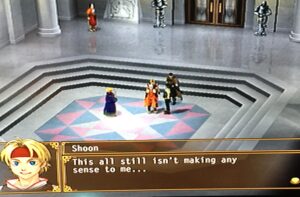
This may be a walk for the uninitiated, but events like these near the end of the game highlight one of my biggest problems with the overall story. Every Suikoden game deals with issues like war and betrayal, and a primary antagonist “testing” the main character is also common in the series as was the case for the final boss fight in Suikoden II. It’s also worth noting that an 80-hour prequel is based on an optional and incredibly brief note in Suikoden II, which is that a knight named Georg Prime kills the Queen of Falena. Ultimately, my beef with Suikoden V after I played through the quests I thoroughly enjoyed was that it felt more Suikoden-esque than Suikoden. Given that Murayama left his baby after the third game, perhaps I shouldn’t have been that surprised that Suikoden V eventually started to feel like Suikoden fan fiction, which I will dive into next.
Have You Ever Waxed Nostalgic in the Pale Gate Moonlight?
See above. The entire plot of Suikoden V is literally derived from a one-sentence “secret” in Suikoden II. This game centers on a civil war between the queen and some evil nobles, reaching peak shitstorm after she goes insane and a loyal knight must kill her on the spot. Perhaps it’s justified because Georg Prime, despite his very small role in the second game, is a fan favorite (I dig him too). You know where this is going, don’t you? That’s right, fellow Suikoden fans. Suikoden V, more than any other game in the series, relies on nostalgia to bolster its narrative. As is true in every other installment, Viki and Jeane are thrown into the game because of course they are. Admittedly, I like them both and appreciated some attempts at character-building, although as is true with every other game, more in-game appearances for those two never actually clarifies why they are in each game. Additionally, characters like Lorelai and Killey have ample screen-time because of the Sindar ruins in the game, but those events never go anywhere. The powerful seer Leknaat also shows up later in the game because, well, it’s Suikoden, but she only ever says, “Here’s your stone tablet,” and, “Congratulations on earning the true ending.” There’s even a shoutout to the Island Nations as one mandatory mission involves traveling to Nirva Island, an island outpost that operates as a mediation point between the Island Nations and Falena. While the game paints this mission as integral to the plot, all it really accomplishes is the Island Nations officially claiming they won’t get involved as Admiral Skald Egan informs the gamer (through Georg) that he’s Ferid’s father, and, therefore, Frey’s grandpa. It’s…never brought up again. You also see stuff like the Maximillian Knights, Shun Min, a character once again referenced in Suikoden II, and a bunch of random shoutouts to other locations and people.
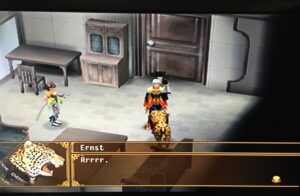
“Check it out, dude. I programmed this dude who morphs into a leopard. We could call it the “Beast Rune.”
“Jesus, Jerry. That was literally the point of the second game.”
“…Really?”
“Well, damn. Is it any good?”
“Lol. No.”
Ultimately, these nostalgic elements initially appear and feel very important to the plot, but they usually just end up as elbow nudges that provide no substantive value beyond, “See what we did there?”
The Suikoden V Characters!
Admittedly, it was fun to see some of these nostalgic characters again, even if the attempt to flesh out their backstories brought more questions than answers. One thing I enjoyed in Suikoden V was that the game often gave side characters like Belcoot, Shoon, Zegai, and many others moments when they could shine. It was interesting that so many characters were given an ensemble role before they are basically kicked to the curb. However, during this playthrough I also found this approach slightly problematic for two reasons. First, one could argue that there are way too many previewed characters in the game. That is, characters you know will be Stars of Destiny. Every Suikoden game operates (or I guess operated?) under the logic that if they have a portrait, they are usually either Stars of Destiny or enemies. In some respects, this practice is nice because it lets the gamer know in advance if they like that character. However, this practice also impacted my playthrough because the game honestly reveals its hand way too early and takes the fun of randomness out of the equation. Very rarely do you have fun moments in Suikoden V like finding Pesmerga in a cave, Futch on a mountain path, Clive inside an inn looking shady, and others. Ultimately, the characters are deemed essential and recruited automatically, or much of the guesswork is taken out of actually finding them. This leads into my second issue with characters in the game, and that is you basically already know who you deem worthy enough to be in your party by the Sable events. Unfortunately, Suikoden V showed during this playthrough that rather than having fun with late-game Stars of Destiny, most in this installment actually kind of suck. The game grants you access to game-breaking melee fighters even before you have a castle. You automatically recruit the game’s best mage (Zerase) who can break the game herself. Hell, any character who can achieve three rune slots during the game means you can play the game with reckless abandon because they are just going to destroy everything in their path.
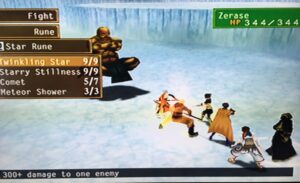
Part of me still appreciates Suikoden V for its motley crew of characters, but it’s almost as if the game stops trying for the thirty or so final Stars of Destiny. Some are characters you meet at the very beginning of the game who finally join you. Others are friends of those characters who automatically join you, so you suddenly have like nine characters who join you at once that you will never use (or can even use if they are “support” characters). You also must recruit six beavers. Fun as a species, I guess, but outside of full-scale battles (their “Gnaw” skill is pretty fun), you’re never going to use them. The last recruit you will potentially use in the game is Cathari because she is practical with her Godspeed Rune and her attack power is off the charts. Aside from that, the penultimate character you can recruit on your own is a gambler named Haleth who does absolutely nothing. In this playthrough, Suikoden V showed me that of the playable 108 Stars of Destiny, only about twenty or so are actually worth bringing to your party. I was honestly surprised at how bad the wheat to chaff ratio was given how long this game is. Still, a lot of characters had value, which is much more than I could ever say about the villains in this game.
Damn, Were the Game’s Villains Always THIS Bad?
With the exception of recruiting towards the end, I appreciated various characters for a variety of reasons. Of course, heroes are only part of any Suikoden game as the villains also play a defining role. Think of any villain in Suikoden. They were pieces of crap, but you could at least see where they were coming from. Let’s be honest. Villains in Suikoden V are just evil for the sake of being evil (you can even make a red hat parallel with the Godwins if you really want to). The game never shies away from this either. You have two Queen’s Knights who are so transparently evil that they project the game’s second act even before you meet the Godwins! Then when you do eventually meet the Godwins, you learn that they are on a quest to Make Falena Great Again through such acts as hiring assassins, burning down actual Falenan cities, and threatening genocide against the country’s diverse population that includes beavers, dwarves, and dragon horses. These dudes are rockin’ neon signs of evil, but perhaps the worst part is that they just aren’t that intelligent.
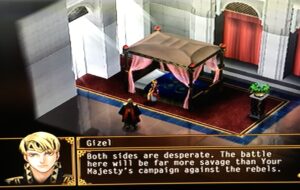
They are confident to the point of smugness, but they are incompetent throughout the game. Although the game constantly projects that characters like the Godwins are “the big bad,” their motives never really venture beyond bad comic book evilness. If you are at all familiar with the Dunning-Kruger Effect, which posits unintelligent people are so confident that they overestimate their abilities, that’s basically every villain in this game. These factions are almost completely devoid of nuance and competency that every battle just becomes a chore. Even worse, the game tries to go to great lengths to make you feel pity for these enemies despite never presenting any reason to do so: “Uh, dudes? This assassin group killed your wife and mother…but you’re going to hire them anyway to achieve your goal of global domination? Yeah, okay.” Man. Maybe Georg should have just let Queen Arshtat use the Sun Rune to burn Falena to the ground.
Geography
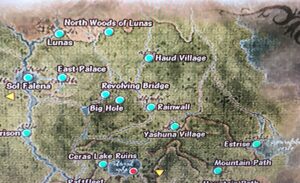
“Hell yeah!”
“…Even further away from the main conflict than Suikoden IV!”
“Wait, what?”
“Ah, yeah! Get it!”
The strange thing is that I used to like Falena in previous playthroughs. It seemed captivating, enchanting, and could have potentially been a nice staging ground for future Suikodens. However, if one of the reasons why I wasn’t too keen on Suikoden IV was because they moved the war theater to a place completely removed from the primary continent, why did I give Suikoden V a pass for moving the game even further away geographically from the earlier games? Yes, the game takes place close to the first game chronologically, but Falena is so far away from the rest of the series’ world that it feels like a one-off entity more than a game that contributed to the world-building experience of the first three games as well as their gaidens. Prior to the existence of Suikoden V, Falena didn’t have to be that far south. It could have been anywhere. Yet for how cool I must have thought relocating to a completely new area was when I first played the game, in retrospect, it does seem sort of alienating for those who wanted some semblance of continuity.
Suikoden Intrigue…That Goes Nowhere
I would argue that what makes every Suikoden game interesting is the level of mystery presented in each game for the sake of world-building. Each game had various hints. Tasty, spicy, delectable hints. These include the relationship between Pesmerga and Yuber, Harmonia’s role in the world, and the climactic battle of all 27 True Runes. Suikoden V joins this party and provides its own random tidbits. Did you know there was an ancient Armes Kingdom whose king went insane while wearing the Sun Rune? There’s a cool little ruin for that. Are you feeling the Sindar stuff from the first couple of games? Well, Suikoden V goes all in on that category. Are you feeling some mysterious characters from foreign lands? Don’t worry. The game is swiping right for you. Suikoden V is loaded with intrigue that goes absolutely nowhere. Perhaps this is the most disappointing issue I experienced while playing the game. There were so many loose ends that were never answered and when they were, they raised eyebrows. Essentially, the Sindar storyline became so half-assed after dozens of hours of playtime that the game basically said the royal family are descendants of the Sindar race because a woman walked down from the snowy mountains that eventually became the game’s final labyrinth (without going into any of that detail). What makes the intrigue in Suikoden V especially problematic all these years later is that we will never get any answers since the series is currently dead. Sindar? Whatever. Characters you like?
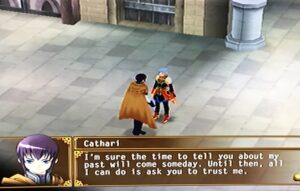
Write some fan fiction. Curious about New Armes and Nagarea? Hell, join the club! Mystery in Suikoden V is presented like a cliffhanger in a television series. Unfortunately, while we know who shot J.R. in Dallas, the cliffhanger in Suikoden V was written in a way that suggests Konami could have gone one of two ways. They could have developed another game that would elaborate on these mysteries, or they could present the cliffhanger so that it could be a series finale just in case the network didn’t pick it up. It sucks to admit, but after fourteen years, it certainly feels like we got the latter.
Conclusion
This turned out to be much longer than I expected. Maybe that’s a good thing because things we love sometimes deserve the full analytical treatment without the rose-tinted nostalgia goggles. Of course, this also proves that quarantine has impacted my gaming patterns of falling back on old titles. On one hand, it feels weird to be critical of a game released fourteen years ago and one that I enjoyed immensely when it came out. On the other hand, replaying the game and discovering its flaws feels sort of cathartic because it also highlights my own gaming habits when I fall back on certain games despite having an immense library I need to tackle.
Ultimately, replaying a game like this perhaps is the jolt I needed to experience more games. Suikoden V is a fun game, but it is so problematic that I finally joined some of my ardent Suikoden fans in recognizing its flaws. Suikoden V will always be special to me, but this latest playthrough shows that I really have played better games since 2006. I never felt I needed to “move on” from Suikoden, but I can start thinking about it as a flawed series rather than the one that got away you think about while slow jazz music plays at the bar. Suikoden is probably dead for all eternity. I can thank the series for its service, remember what I loved about it, and discover new gems I have on my shelf.
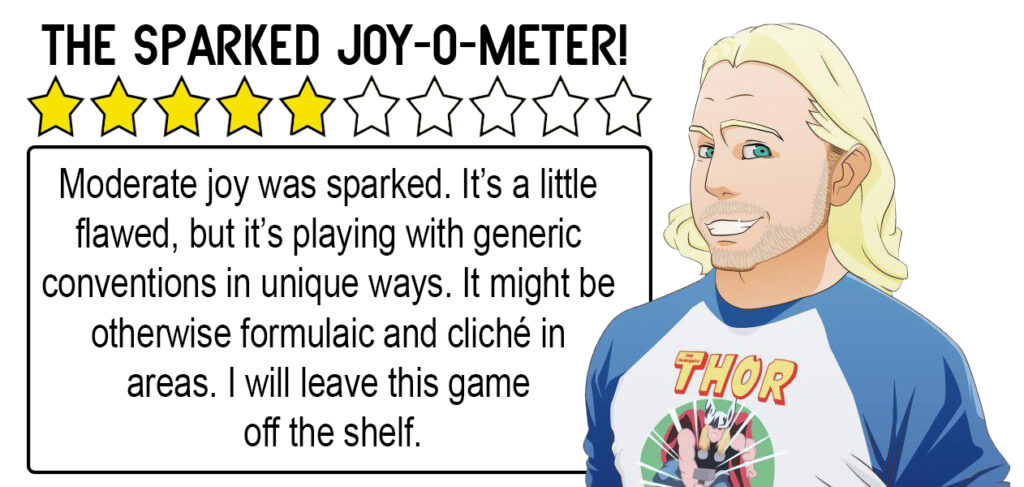
Well, this was a treat to read. It’s not common to find long-form blog posts about my favorite series anymore!
“Each had only a couple thousand members, but they were so enthusiastic about Suikoden that we all felt as if the series would remain relevant for years.” I absolutely feel you on this particular sentiment. I have vivid memories shortly before the launch of Suikoden IV, hanging around my favorite internet buddies discussing the series in-depth for hours and thinking to myself, “I could do this forever!”
(I suppose it’s not a *huge* stretch, given there’s still dozens of us doing the same stuff years later.)
You touch upon a lot of the points I felt when undertaking my first playthrough of Suikoden V. I enjoyed it, but it almost felt like it was trying too hard to capture the ‘lightning in the bottle’ from the second game and the charm from the third game, but the results often rang hollow. It makes conscious attempts that oftentimes feel hamfisted, or like they had a checklist of “how to make a Suikoden game” and ran through the motions.
As someone who does actually enjoy dabbling in the creation of fanworks, the fifth installment is the one that inspires me the least to write or doodle. In a world full of games I could be playing in my backlog, picking this particular title up for a replay during quarantine time would come low at my list, and only after the completion of the previous three titles. (Okay, maybe I’d begrudgingly replay Suikoden IV as well, if only to take advantage of the New Game+ perks and the fact that the opening doesn’t take over a dozen hours to get past).
We can only hope others continue to discover the series and draw their own conclusions or spin up their own interpretations. The internet is a rich platform for sharing ideas, so while we’ll never get another true installment in the series, we can at the very least commiserate and theorize with others. Who knows, maybe Murayama will divulge some tidbits now that he has a Twitter account! Although I suspect he’d be far happier sharing adorable pictures of dogs instead.
Yep, the whole Godwin thing is the real headscratcher. They’re overwhelmingly evil, racist, genocidal, regicidal villains who are stimmed at every single turn, with even their smallest victories being presented as part of your strategist’s master plan, but by the end, the game tries to pull an “alas poor villain” routine as they finally begin to fall, with talks of fighting with honor, truly caring for Falena, and accusations that perhaps you’re Not So Different before the final battle. What? I’m not the one that razed towns in my own country while trying to enact genocide on the “demi-humans”! That’s you guys!! Truly farcical.
The game is really hurting for some sense of nuance, even in a series where you’re clearly the “good guys” in every single title.
Cathari, Cathartic. I see what you did there.